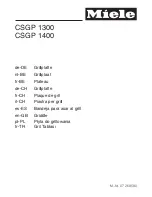
Part # 9229077 (05/28/09)
Page 7
INSTALLATION Continued
Positioning and Setup
Some form of mechanical assistance will be required to
position these broilers, as the smallest weights almost 75
(seventy-five) pounds with the larger sizes near 600. A pallet
or lift jack will also make leveling easier, as these units are
designed to sit flush on a counter, do not have adjustable
legs or feet, and leveling is with shims and repeated fitting.
Inside the unit, Char-Broilers using tubular burners (the
“Regal
”
Series) and either cast iron or stainless steel radiants
will have the burners taped to the rear burner hanger to
stop vibration and possible damage during shipment. This
tape must be removed prior to lighting the pilots. Once free,
double-check that the burners are positioned squarely in the
notches of the back burner holder. If they are out of position,
the burner will not work properly.
Ceramic coals are wrapped in a bundle and packed inside the
broiler, on top of the lower grates. These are to be arranged
one coal deep only over the grate surface, but installation
will be easier if they are placed after the pilots are lit and
burners tested, permitting the bottom to be removed to
check burner operation.
Air Supply and Ventilation
The area around the appliance must be kept clear to avoid
any obstruction to the flow of combustion and ventilation
air, as well as, for ease of maintenance and service.
Means must be provided for any commercial, heavy-duty
cooking appliance to exhaust combustion waste products
to the outside of the building. This is doubly important for
open grate broilers, since the design promotes grease and fat
dripping through onto hot radiants sending smoke back up
onto the product as seasoning. This smoke then continues
either up to the ceiling or to an exhaust hood.
Garland Char-
Broilers must be under a vent hood!
Filters and drip troughs
should be part of any industrial hood, but consult local codes
before constructing and installing a hood.
Air movement should be checked during installation, Strong
exhaust fans in this hood or in the overall air conditioning
system can product a slight vacuum in the room and/or
cause air drafts, either of which can interfere with pilot or
burner performance and be hard to diagnose. If pilot/burner
outage problems persist, make-up air openings or baffles
may have to be provided in the room. Do not block, and
maintain adequate clearance for the appliance’s designed air
openings
Gas Connection
NOTE: The gas supply (service) line must be the same size or
greater than the inlet line of the appliance. Garland Char-
Broilers use a 3/4
”
NPT inlet. Sealant on all pipe joints must be
resistive to LP gas
The appliance and its individual shut-off valve must be
disconnected from the gas supply piping system during any
pressure testing of that system at test pressures in excess of
1/2 psi (3.45 kPa).
The appliance must be isolated from the gas supply piping
system by closing its individual manual shut-off valve during
any pressure testing of the gas supply piping system at test
pressures equal to or less than 1/2 psi (3.45 kPa).
Manual Shut-Off Valve
The Manual Shut-Off Valve is supplied by the installer, it must
be installed in the gas service line ahead of the appliance
and regulator in the gas stream and in a position where it can
be reached quickly in the event of an emergency.
Pressure Regulator
All heavy-duty, commercial cooking equipment must have
a pressure regulator in the incoming service line for safe and
efficient operation, since service pressure may fluctuate with
local demand. The manual shut-off valve is normally supplied
by the installer, but pressure regulators are shipped from
Garland with every Char-Broiler.
Regulators are pre-set at the factory for 5
”
WC (natural gas)
or 10
”
WC (propane) according to the customer’s ordering
instructions.
Prior to connecting the regulator, check the incoming line
pressure, as these regulators can withstand a maximum
pressure of 1/2 psi (14
”
WC). If the Line pressure is beyond
this limit, a step-down regulator will be required. Double-
check the arrow forged onto the bottom of the regulator
body which shows gas flow directions; it should point
downstream to the appliance. The red air-vent cap is part of
the regulator and should not be removed unless local codes
require external venting.
Regulators can be adjusted in the field, but it is
recommended that they not be tampered with unless that
part is known to be out of adjustment or serious pressure
fluctuations are found to exist and can be solved no other
way. Any adjustments to regulators must be made by
qualified service personnel with the proper test equipment.
































